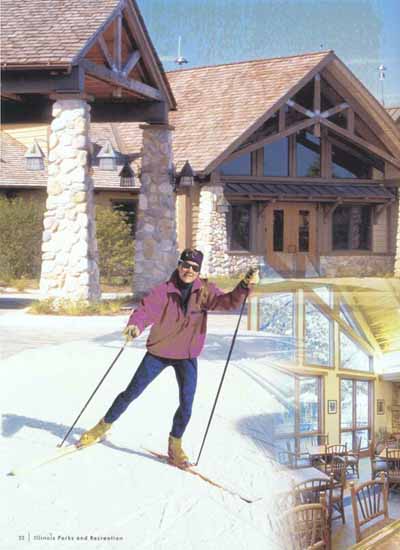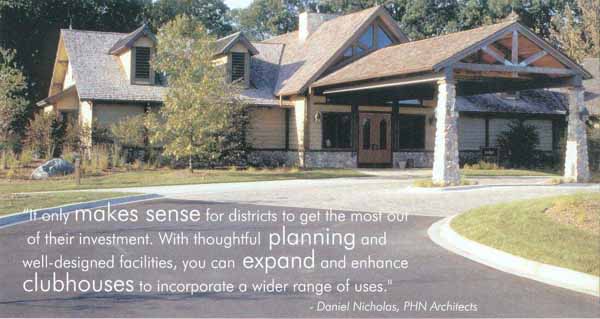 |
Home | Search | Browse | About IPO | Staff | Links |
 |
Home | Search | Browse | About IPO | Staff | Links |
|


How to make your clubhouse a revenue-generator all year long In Illinois, "fore" is not a word used on golf courses year-round. Winter's cold and snow prompt park and forest preserve districts to close their courses for several months. That means ancillary facilities, particularly clubhouses, take on extra importance as districts look for ways to use existing golf facilities—in all seasons—to boost revenues. Some districts shut down clubhouses in the off-season and others do not. Some turn their clubhouses over to a concessionaire for use in the winter to utilize the facilities for special events. When considering a new, remodeled or expanded clubhouse as a means to that bottom-line-boosting end, officials suggest keeping these ideas in mind.
First, evaluate in-depth the reasons for remodeling to pinpoint precisely what is desired, recommends Daniel Nicholas, a principal at PHN Architects in Wheaton. A simple facelift probably will not significantly impact revenue, if core issues—inefficient kitchen facilities or insufficient space—aren't addressed. "Districts are paying a lot of money to have a building that's not functioning for a period of time," says Nicholas. "Districts can continue to generate revenue in the off months from their banquet facilities. Districts with facilities use them and districts without them would love to add them." For agencies mulling building projects, what points should they consider? • First and foremost, says Ed Clift, executive director of the Byron Forest Preserve District, which runs PrairieView March/April 2003 23

Golf Course, "I would make sure you had a separate banquet facility that could seat up to about 300." Byron began working with PHN six years ago on a staged project to convert a large cart barn into a banquet hall. "Before, we had to use a big tent and that didn't work for us very well," says Clift. In 2002, Byron hosted approximately 100 golf and banquet outings, generating $250,000 in revenue. "The fact that we had a banquet facility allowed us to do this. These outings would have gone to another course and we would have lost that money without this type of facility." In fact, according to Clift, a competing course 12 miles away has lost tournaments to Byron because of lack of banquet facilities. "Golfers don't want to have to get in their cars and drive five miles to a new spot for the after-golf banquet," says Clift. "Organizers will go somewhere else. Every district's situation is different but if you have the space and can afford a banquet hall, there's some good money to be made there." And bigger is usually better. The Waukegan Park District's Bonnie Brook Golf Course has banquet facilities for 175. "Particularly for weddings, which are quite profitable, 250 is the golden number," says David Beno, Waukegan's superintendent of golf courses. "People hear '175' and right away you're off the list." • Menu, location and size all impact kitchen design. Solutions will vary according to the specifics of a particular clubhouse, but districts should address—among many points—what kind of events will be hosted, whether multiple food preparation areas are needed and the location of these facilities. "You don't necessarily need a large kitchen capable of turning out a meal for 200-plus people," says Nicholas. "Perhaps banquet food will be catered in, with the clubhouse kitchen handling side dishes that can be prepared over time and then stored until needed. The staff, at the same time, might provide food to foursomes coming off the course." For Bonnie Brook Golf Course, PHN designed a satellite kitchen for the new casual grill. "There was no need for a whole walk-in cooler, because that's in the main kitchen," says Nicholas. "The satellite kitchen just required a refrigerator. "Menu development is also key here. We very closely examine all these details in the design process. A poorly designed kitchen is a huge impediment." • "Keep your overhead costs for your grill as low as possible," advises Beno. That means designing an efficient facility that can be run by no more than two people, with foods that can be March/April 2003 25

cooked quickly, and presented attractively. • "It's critical to make sure the space and market are closely related," says Chuck Szoke, director of Channahon Park District, which operates Heritage Bluffs Golf Course. "Don't over-build or under-build. That space is expensive to build and maintain. If you're not filling it or using it optimally, that space is even more expensive." District officials should determine what competing facilities, be they VFW halls or private banquet facilities, are available to prospective clients. Sizing the kitchen appropriately is a related concern. "Don't get stuck with too much kitchen for not enough space, and vice versa," says Szoke. • Consider service issues such as deliveries and refuse pickup. "Those will increase if you enlarge your facilities," says Nicholas. "We look at how those services are provided and how they blend into the overall site circulation. When such activities go unnoticed by the public, that's when you have achieved a successful design." • Separate your visitors. PHN worked with Waukegan to remodel its clubhouse two years ago to maximize existing space, create a new casual grill and provide separate entrances for golfers and banquet-goers. Previously, there had been increased intermingling of the two groups and Waukegan wanted to give each its own facilities. "Our golfers are ecstatic," says Beno. "They have their own space and so do banquet-goers. And revenue is up at least 15 percent." The three-year-old ThunderHawk Lodge, part of ThunderHawk Golf Club in Beach Park, was designed from the beginning to have separate banquet facilities, says Bob Speckmann, facility development manager for the Lake County Forest Preserve District. The district runs ThunderHawk, designed by Robert Trent Jones Jr. Accordingly, PHN's design incorporated special event space that could be isolated from the remainder of the club, with its own support facilities. The covered carriageway— ThunderHawk's elegant porte-cochere- protects banquet guests from winter's snow and sleet. • Have all partners on board during the design process. "If there are going to be multiple uses, partnered out to different entities, it's important to have their input included in the design rather than be late to the party," says Speckmann. "For example, caterers brought in later might need extra space or would have preferred a different layout. And now they have to make it work, even though it's not what they would like." • Design with an eye toward the future. "We sited our building on the property so we have the room to expand later," says Szoke. "Don't design yourself out of that option." • Incorporate great views. "Try to get a view of the 18th hole," recommends Speckmann. • Be versatile. Design space that can be configured tor" different size groups. 26 Illinois Parks and Recreation
• Consider audiovisual issues. Private companies rent Heritage Bluff for sales meetings and training, taking advantage of the club's televisions and VCRs. Says Szoke: "Districts may want to look at Internet capabilities, so companies can hook into their own Web sites." Of course, banquet facilities are not the do all, be all and end all. Districts also use a variety of ways to enhance wintertime revenues at their golf courses and clubhouses. • Use the clubhouse for private parties. Oak Lawn's Stony Creek clubhouse doesn't have banquet facilities but it can seat 125 in one large or two small spaces. Christmas and holiday parties are usually booked a year in advance and Stony Creek is a popular choice for First Communion parties, baptisms, family reunions and showers. Byron began aggressively recruiting private parties in the winter, when the clubhouse is shutdown. "People bring in their own caterer and we run the bar," says Clift. The district charges a small per-person fee, plus it makes money on the bar. Of 18 such private non-golf rentals last year, 15 were during the down season.
• Two golf simulators draw duffers yearning for spring at Stony Creek Golf Course. The facility also includes four televisions, plus a big-screen set to draw those who want to watch sporting events.
• Add an ice rink.
Oak Lawn wants to turn its golf course into a year-round draw, including a "winter wonderland" facility. "We tried just a pond, but because of inconsistent weather we need a refrigerated rink," says Maddie Kelly, director of the Oak Lawn Park District. "And a fireplace creates a cozy atmosphere." • Open up the course for crosscountry skiing with the clubhouse doubling as a warming house. "It only makes sense for districts to get the most out of their investment," Nicholas says. "With thoughtful planning and well-designed facilities, park districts and forest preserve districts can expand and enhance clubhouses to incorporate a wider range of uses. And that's good for everyone."
Beth Bales Photographs of the Lake County Forest Preserve District's ThunderHawk Lodge by Robert McKendrick and courtesty of PHN Architects.
March/April 2003 27 |
|
|